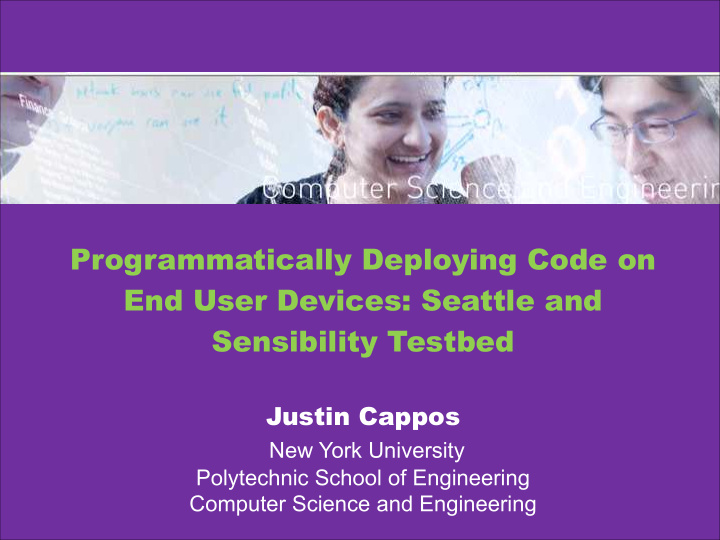



Programmatically Deploying Code on End User Devices: Seattle and Sensibility Testbed � Justin Cappos New York University Polytechnic School of Engineering Computer Science and Engineering
Observations from AIMS Crowdsourcing provides a useful platform • Buying hardware does not scale! • User safety is paramount − Security / Performance isolation − Privacy Policies − Bundling with apps is important Experimenters want rich interaction • Flexible expt type / timing / frequency • Computation with a (standardized?) API • What abstraction? • Does generality cause problems?
Our Vision Securely Compute on Edge Devices
Our Vision Securely Compute on Edge Devices
Our Vision Securely Compute on Edge Devices
Our Vision Securely Compute on Edge Devices
Seattle Testbed Open peer-to-peer application hosting • Unknown users donate resources (VMs) − Performance isolated to 10% • Unknown developers push code − Security isolated so “do no harm” • Tit-for-tat like model for resource sharing • Commonly used like a P2P PlanetLab � https://seattle.poly.edu/
Practical use • Deployed services • Intelligent distributed storage • Dynamic DNS remapping • Transparent network optimization • Censorship avoidance and measurement • YouTube CDN mapping • Etc. • Community support • Android / OpenWRT / Raspberry PI port • Runs on PlanetLab, Emulab, GpENI, DOME, etc. • GENI workshops, PyCon, etc. • Port to Nokia N900 by Nokia • NaCl integration by U Victoria / HP Labs • iPad 2 port, tun / tap support, etc.
Educational use • Classroom experience • Released in Spring 2009 • Used in >50 classes (so far) • 3 tutorials, 3 library references, etc. • 11 battle tested assignments (Networking and Security) • Overlay routing, flow control, NAT / Non-transitive connectivity, Chord (DHT), web / chat servers, reference monitors, NAT tunneling, etc. • OS classes are coming � • Community support • Supported by educational groups • NWDCSD, HandsOnSecurity • 2 SIGCSE papers, 3 CCSC workshops, etc. • Top ranked SIGCOMM Educational Resource • Coming in Computer Networking by Kurose & Ross • Most popular networking book!
What Our Current Status?
What Our Current Status?
What Our Current Status?
What Our Current Status?
What Our Current Status?
What Our Current Status?
What Our Current Status?
Demonstration Typical Seattle Workflow • Registration • Download installer • Acquire resources • Use Seattle public clearinghouse • Deploy application ● Use shell to locate and control resources ● (All Pairs UDP Ping?)
Thanks to:
Summary Seattle / Sensibility conclusion • Seattle widely deployed around the world Geographic diversity, network diversity, device diversity... ● Tens of thousands of installs, thousands of VMs online at a ● time, thousands of developers • Battle tested educational / research / app platform! • Discussion: Where might we fit in? • Testbeds (Seattle / Sensibility) for experimentation • Common library for experiments • Collab(?) with mobiperf (expose their measurement libs) • Toolkit for easily building customized testbeds • Seattle, BISMark, ToMaTo, Sensibility Testbed, ICLab, SocialCloud, SciWiNet(?), PhantomNet(?), Mitate(?), etc. https://seattle.poly.edu/ SeattleOnAndroid (Google Play) �
Thanks!
Recommend
More recommend